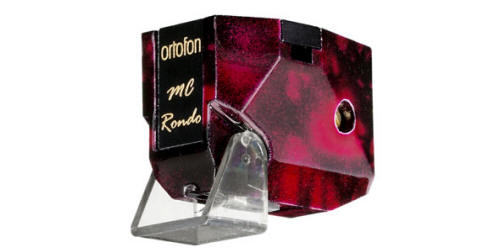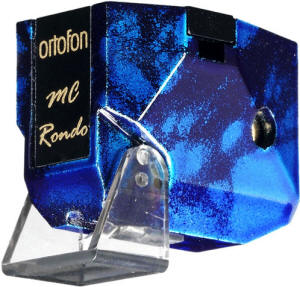|
|
You are reading the older HTML site
Positive Feedback ISSUE 65
ortofon Rondo Red Phono Cartridge as reviewed by Ed Kobesky
Looks aren't always deceiving. President Obama looks like a guy who's more comfortable organizing communities than shooting skeet. Jeep's 470-horsepower Grand Cherokee SRT8 looks like it can launch your family to grandma's house at 155 miles per hour. I look like the kind of guy who wears sweater vests. Sometimes, one look tells you all you need to know. Likewise, peeping the Rondo Red with the right set of eyes tells you about its intended audience. While Ortofon's Cadenzas are sleek metal things shaped like spaceships, and their 2M series is perfectly chiseled and adorned with a slick logo, the Rondo is conspicuously made of wood. Well, 55% wood dust or something in a resin matrix, but still. It's beautifully finished in Urishi laquer, with a marbled/burled look that screams I belong in a room full of polished mahogany and brass. By the way, you know what else has a Urishi laquer finish? Dunhill Namiki smoking pipes. Know what one costs? $8500. (Thanks, Google!) Just goes to show that audiophiles aren't the only folks capable of spending batshit crazy money on stuff nobody really needs. However, since the Rondo Red is only $639, you can buy it instead of the Dunhill and rationalize that you saved $7861.
If you want to save less, you can buy the Rondo Blue with nude FG70 stylus for $879 or the Bronze with finer FG80 stylus and improved cantilever for $1159. Ortofon's literature promises a more ‘homogeneous' sound as you move up the line, which I'm sure is the result of poor translation from Danish to English. However, they save the best for the Red: "Perfect with all sorts of not very complex music." Which is kind of like saying your kid is the smartest one in summer school. I don't know if Ortofon is startlingly honest, hires the world's worst ad writers or just wants to upsell like crazy because the Rondo Red is in fact very good precisely where they claim it is lacking. It can clearly distinguish not only different instruments but also different sections of the same instrument. Ortofon further states that the "sound image will tend to less dynamic strength and smoother reproduction." If that's the case, I gotta hear the more expensive models in this range because the Red at least equaled the dynamics of my older model Dynavector 10x4 with rock music and surpassed it with classical by virtue of not only raw slam but also refinement. So its looks aren't deceiving at all. This cartridge is James Bond all the way, ready to kick some butt at a moment's notice without getting so much as a hair out of place. It is, by the way, equally content trying to pick up Halle Berry at a quiet cocktail party. All of its ability to sort out complex passages translates to remarkable adeptness with small-scale jazz or acoustic music. Low-level detail and ambience cues have nowhere to hide. It's rich but still agile. Still, no cartridge is perfect and this one has a few odd tendencies. One minute, I'd marvel at how it picked out tiny details or distinguished instruments that would mush together with lesser cartridges. The next, I'd be wondering why it sounded just a little too polished. Sometimes, especially on bad pressings, this was welcome. Other times, I felt like I was missing the some of the grit, the little bits of real life that make music thrilling. Notes could sound just a little too perfect, a little too synthesized. Also, while smooth and decently delicate at the top (though not as extended as some competitors), bass notes lack specificity at the lowest octaves. There's no such thing as a free lunch. Mounting the Rondo Red was easy thanks to its threaded base and built-in stylus guard. It's tall, so be sure you have enough arm height adjustment. It's also on the heavy side at 10.5g grams, but hey, you'd be heavy too if you were made out of trees. Otherwise, this isn't a very finicky cartridge. Output is healthy by MC standards at 0.5mv. It should work perfectly even in phono stages with a non-adjustable MC setting since the default is usually 100ohms loading, the sweet spot in my listening. Ortofon says you can get more 'air' if you load it at a higher value. I didn't notice dramatic differences using the Avid Pulsus (reviewed here) but you may. Soundstaging was satisfying in every direction in any event and only in extreme circumstances did it sound truncated. So, you want a cartridge that offers insight without edginess? Drama without carnage? This could be just the ticket. What it does right, it does really right. What is does wrong is forgivable. If you can live with musical notes that gently fade away instead of dying out, with trumpets that sound spitty minus the actual spit, then you can get a heck of a deal here for $639. Polished, yes, but miles from dull. Ed Kobesky
Ortofon Blue
Ortofon
|









